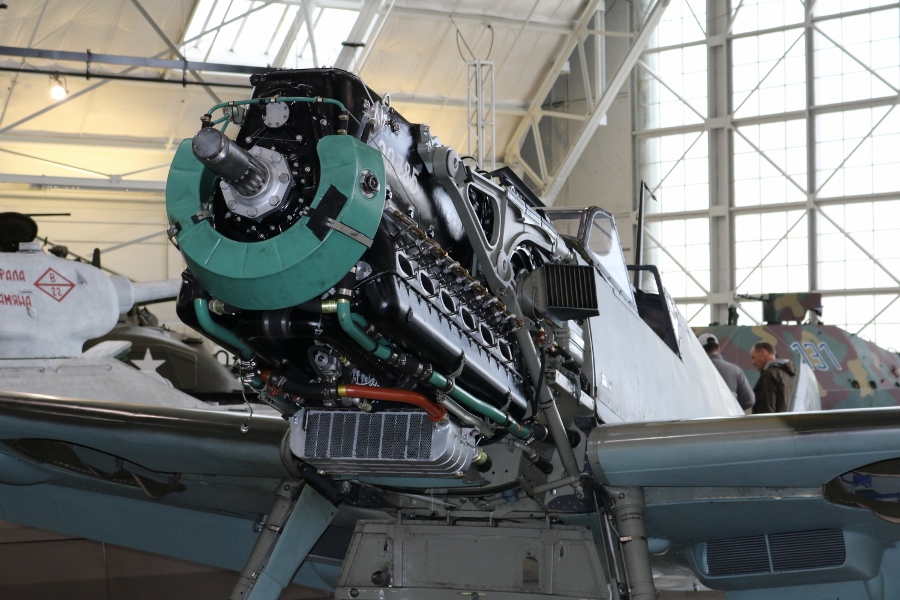When you think of Luftwaffe fighter aircraft during World War Two, the infamous Messerschmitt Bf 109 is an aircraft that generally springs to mind. Blooded during the Spanish Civil War (1936-1939), the Bf 109 was involved from the early Blitzkrieg of Europe in 1939-1940 to the Battle of Britain in 1940, the Eastern Front from 1941 to 1945 and basically any battle front that Germany fought on during the conflict.

By 1945 there had been approximately 34,000 Bf 109’s manufactured (A, B, C, D, E, F, G and K models), making it the most produced fighter aircraft in the world (in comparison over 20,000 of its Luftwaffe contemporary, the Focke-Wulf Fw-190 fighters were built). It was also flown by other Axis countries during World War Two including Bulgaria, Croatia, Finland, Hungary and Italy.
Given how prolific the Bf 109 was, there is no surprise that it is said to have destroyed more enemy aircraft than any other fighter in World War Two (especially on the Eastern Front). Many of the top German air aces flew the Bf 109 during their careers and just over 100 of them achieved 100 plus aerial victories including the legendary Luftwaffe General Adolf Galland with 104 victories. 13 had over 200 including the third greatest air ace of all time Günther Rall with 275 victories and 2 had over 300 making them the greatest air aces of all time – Erich Hartmann 352 victories and Gerhard Barkhorn 301 victories. This group of air aces and their fellow pilots destroyed nearly 15,000 enemy aircraft flying the Bf 109!

The Messerschmitt Bf 109E-3 Emil (Werk Nummer 1342) at the Flying Heritage Collection is fully flight capable and a regular performer during their summer flying days. Manufactured in Germany in October 1939, it was operated in France with Jagdgeschwader 51 (JG.51) Mölders and flown by Eduard Hemmerling (6/JG.51) who was credited with shooting down 3 aircraft (note the tally markings on the tail of the FHC aircraft): an RAF No.54 Squadron Supermarine Spitfire over Dover whilst escorting Junkers Ju-87 Stuka dive bombers on July 7th, 1940, an RAF Bristol Blenheim on July 9th, 1940 near Cap Blanc Nez and another RAF Supermarine Spitfire on July 27th, 1940 west of Cap Blanc Nez (reference JG.51 claims).


During that latter engagement Hemmerling’s aircraft was damaged though and he never made it back to France. Crashing off the coast of Cap Blanc Nez he died in the incident and the aircraft sat there for the next 48 years. It was rediscovered in 1988 by a man walking along the beach who noticed the tip of the wing sticking out of the sand! This lead to its recovery, restoration and return to flight in 2003.
Leading up to its first flying performance for 2016 has seen the Daimler Benz DB 601Aa liquid-cooled, inverted V12 1159 hp inline engine removed for maintenance (in its World War Two prime these types of engines powered the Bf 109E fighters up to a maximum speed of around 560 kmph or 348 mph). Keeping this historic aircraft (77 years old!) in as new and working condition is an ongoing challenge and a team of skilled mechanics are kept busy all-year round!

Now the DB.601Aa engine is back on the aircraft and getting prepared for flight (the inverted design kept the centre of gravity low and allowed for better pilot visibility over the aircraft nose). This gives us a great opportunity to have a look under the cowl and see this famous engine in all its glory.















The Flying Heritage Collection provides a great opportunity to see original military aircraft up close, under the cowl and in the air. It is a great museum to visit any time of the year but summer is the time to see these warbirds fly!

Nice to see the inner workings, thanks 🙂
LikeLiked by 2 people
Adolf Galland survived the war and visited Australia during the 1970s. He was made welcome at RAAF Point Cook, or maybe it was Laverton.
LikeLiked by 2 people
I didnt realise he came to Australia but I know he became somewhat of a celebrity after the war. His book is a good read
LikeLiked by 1 person
I have a memory of reading the story in the Melbourne Sun, at my grandparent’s place. I would have been there on holidays, so that narrows it to 1971-75.
LikeLiked by 1 person
They are incredible figures – 15,000 aircraft shot down!
LikeLiked by 1 person
[…] Bf 109E-3, it’s long restoration and finally a return to flight in 2003 with an original Daimler Benz DB 601Aa liquid-cooled, inverted V12 1159 hp inline […]
LikeLike
[…] Engine maintenance photo of a JG26, Bf 109E-4, & Bf 109E-3 Jagdgeschwader 26 formation in 1940, https://acesflyinghigh.wordpress.com/2016/06/25/under-the-cowl-of-the-flying-heritage-collection-bf-… – Bf 109E3, Africa, http://www.wikiwand.com/fr/Messerschmitt_Bf_109, – FW190A3, JG51 […]
LikeLike
Very interesting article and pictures of the Messerschmitt Bf109E. Regarding the II./JG51 badge of the Raven; is it a “raven with a cold”, as your article says, OR is it a “weeping raven”, like it’s said in books on the Messerschmitt Bf109E?
LikeLike
“Verschnupfte Rabe” runny nose, cold etc. This is what it generally refers to in most information I have read on JG.51
LikeLike